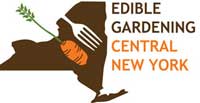| Planting trees for the future |
 | | Pine tree |
|
When our concept of land ownership was generational, it must have seemed ordinary to plant a line of sapling sugar maples that someday one's grandchildren would tap for maple syrup.
Sugar maples planted along New England roads are well over a century old, some close to twice that age, but hardly anyone is planting young ones.
I think this is deeply wrong, or at least inordinately selfish.
I know my land will pass into the hands of strangers; even so, I owe them its future.
In our present and difficult transition to a wiser suburban landscape, we are all pioneers, preparing the ground for its future occupancy.
~ Sara Stein, Planting Noah's Garden, pp. 58-59
Be a pioneer!
Instead of today's trend of decorating your yard with small, non-native, mass-produced trees, choose native trees -- yes, even large ones -- that leave a legacy for the future occupants of your home as well as for future generations.
|
| Our Habitat Garden |  |
Visit Our Habitat Garden website for information on providing habitat, earth-friendly gardening practices, plants, and various creatures here in Central New York. |
| HGCNY on Facebook |
As as more of us participate on our Facebook page, this will become a useful resource for asking (and answering!) local HGCNYers' questions about habitat gardening. Join in what can become a very useful conversation about habitat gardening in Central New York.
|
|
Join HGCNY!
|  |
Becoming an official member of HGCNY is easy: just join Wild Ones! When you're a Wild Ones member, you're automatically an official member of HGCNY. |
| Our Edible Garden |  | | Visit OurEdibleGarden.org to see an example of a Central New York edible garden, the perfect companion to your habitat garden. |
| Interested in Edible Gardening? | 
|
If you'd like to get information on Edible Gardening CNY, just email John to find out about edible gardening tours and programs.
|
|
Greetings!
 Our tenth anniversary! Our tenth anniversary!HGCNY started in March of 2002. Thank you to all the people who have helped us get off on a solid footing, especially my fellow co-founders Michelle Welcher and Dan Carroll.
Many others have helped us along the way, such as Estelle Hahn and Hope Kuniholm, and I'd like to especially thank our current planning committee members who keep us growing: Sylvia Albrecht, John Allen, Carol Biesemeyer, Peter Huntington, Soule Leiter, Beth and Dave Mitchell, Linda Rossiter, and Randi Starmer.
Thank you, too, to all the people who share their expertise and enthusiasm at our programs, as well as all of you who "like" us on Facebook and help spread the word about the benefits of native plants and natural landscapes.
 Cedars, Samphire, Sassafras: Cedars, Samphire, Sassafras:
Historical Plants of Onondaga Lake
We're pleased to have Catherine Landis of SUNY-ESF at our 10th anniversary meeting to share the history of plants in one of Central New York's defining features: Onondaga Lake.
What was Onondaga Lake like before becoming a sink for pollutants? What plant communities could be found growing around it? What were the cultural connections to these places and plants? In this program we will explore these questions, beginning with post-glacial settings and moving up to the 1800s. This story of place will be woven from clues in sediment cores, old maps, missionary and explorers' journals, botanical records and other sources.
WHEN: Sunday, March 25 at 2:00 PM
WHERE: Liverpool Public Library (Directions)
Free and open to the public.
Come and bring a friend!
 Cancellations? Cancellations?
In HGCNY's ten-year history, we've cancelled very few programs, but here in CNY, storms are always a possibility.
If the weather is bad, call Liverpool Library at 457-0310 to see if it's closed. Also, look for an email or check Facebook or our website for cancellation information.
Where to find native plants?
One of the most common questions we hear is, "Where can I find native plants?" HGCNY will help you find them! We're compiling a list of native plants available in Central New York, and we'll be publishing it soon.
~ Janet Allen
|
|
|
Featured plant: Rhus
 | | Fragrant sumac berries |
Even if you haven't heard of "Rhus" (pronounced roos), you likely know the plant. Rhus is the genus name for sumacs.
And as William Cullina, in his excellent book Native Trees, Shrubs, & Vines points out, "Sumacs definitely have an image problem." On behalf of the genus Rhus, Cullina came up with a slogan: "Rhus: We want to be your only shrub" as well as the acronym SUMACS: Sexy, Undemanding, Mellifluous, Appropriate, Colorful Shrubs. Rhus certainly excel in the color department. As Cullina says, "Sumacs are wizards at fall color." (Check his book on p. 218 to learn more about these traits.)
Sumacs do tend to spread, or, as Cullina puts it, "they display a healthy curiosity about the surrounding landscape."
If you have a small yard, Rhus may not be the plant for you, but probably many more yards could use them than we realize.
People first think of the common staghorn sumac (R. typhina), which itself is a beautiful plant if we get beyond automatically categorizing it as a "weed." But there are also many other species in the genus, including fragrant sumac (R. aromatica) (though not fragrant in the usual sense), shining sumac (R. copallina), and smooth sumac (R. glabra).
Do a little research on the particular characteristics of each of these species, and you may find the easy to grow, beautiful, wildlife-friendly plant you've been looking for.
|
|
The results are in!
 | |
Chickadees: The most-seen species in Syracuse
|
Audubon and Cornell's Lab of Ornithology have tallied the results of the Great Backyard Bird Count event a couple of weeks ago. If you didn't get a chance to participate this year, it will take place on the same weekend next year.
Here are some of the highlights, but you can get MUCH more information on the GBBC website:
The most common species reported overall:
1) Northern Cardinal on 48,802 checklists
2) Mourning Dove - 47,925
3) Dark-eyed Junco - 43,792
4) Downy Woodpecker - 38,264
5) American Crow - 36,060
The most numerous birds overall:
1) Snow Goose - 3,259,469 individual birds
2) Tree Swallow - 3,060,169
3) Red-winged Blackbird - 1,719,373
4) Canada Goose - 932,013
5) Common Grackle - 578,625
States submitting the most checklists:
1) New York - 6,519 checklists submitted 2) California - 5,625 The most common species in New York State: 1) Black-capped Chickadee on 4,161 checklists 2) Mourning Dove - 3,300 3) Downy Woodpecker - 3,201 4) Blue Jay - 3,063 5) Dark-eyed Junco - 3,017 6) Northern Cardinal - 3,015 7) American Crow - 2,900 8) American Goldfinch - 2,469 9) Tufted Titmouse - 2,417 10) White-breasted Nuthatch - 2,398 The most numerous birds in New York State:
1) Canada Goose - 78,573 individual birds 2) Snow Goose - 39,695 3) European Starling - 28,012 4) Ring-billed Gull - 27,720 5) American Crow - 23,993 6) American Goldfinch - 21,513 7) House Sparrow - 19,403 8) Redhead - 19,065 9) Mourning Dove - 18,534 10 Brant - 17,517 Most common species reported in Syracuse The top 10 of the 44 species reported: 1) Black-capped Chickadee on 26 checklists 2) Mourning Dove - 25 3) American Crow - 23 4) Downy Woodpecker - 22 5) Dark-eyed Junco - 20 6) Northern Cardinal - 20 7) House Sparrow - 19 8) American Goldfinch - 16 9) Blue Jay - 14 10) White-breasted Nuthatch - 14 Most numerous birds reported in Syracuse 1) American Crow - 1,239 individual birds 2) Ring-billed Gull - 267 3) House Sparrow - 222 4) European Starling - 116 5) American Goldfinch - 85 6) Dark-eyed Junco - 83 7) Mourning Dove - 83 8) Black-capped Chickadee - 77 9) Rock Pigeon - 68 |
|
|
|
|